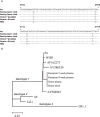Parvovirus B19 infection transmitted by transfusion of red blood cells confirmed by molecular analysis of linked donor and recipient samples
- PMID: 20158689
- PMCID: PMC5547753
- DOI: 10.1111/j.1537-2995.2010.02591.x
Parvovirus B19 infection transmitted by transfusion of red blood cells confirmed by molecular analysis of linked donor and recipient samples
Abstract
Background: Extremely high viremic levels of parvovirus B19 (B19V) can be found in acutely infected, but asymptomatic donors. However, reports of transmission by single-donor blood components are rare. In this prospective study, paired donor-recipient samples were used to investigate the transfusion risk.
Study design and methods: Posttransfusion plasma or blood samples from recipients were tested for B19V DNA by polymerase chain reaction, generally at 4 and 8 weeks, and for anti-B19V immunoglobulin (Ig)G by enzyme immunoassay, at 12 and 24 weeks. To rule out infection unrelated to transfusion, pretransfusion samples and linked donor's samples for each B19V DNA-positive recipient were assayed for B19V DNA and anti-B19V IgG and IgM. To confirm transmission, sequencing and phylogenetic analysis were performed.
Results: A total of 14 of 869 (1.6%) recipients were B19V DNA positive, but only 1 of 869 (0.12%; 95% confidence interval, 0.0029%-0.6409%) was negative for B19V DNA and anti-B19V IgG before transfusion and seroconverted posttransfusion. This newly infected patient received 5 × 10(10) IU B19V DNA in one red blood cell (RBC) unit from an acutely infected anti-B19V-negative donor in addition to RBCs from three other donors that cumulatively contained 1320 IU of anti-B19V IgG. DNA sequencing and phylogenetic analysis showed that sequences from the linked donor and recipient were identical (Genotype 1), thus establishing transfusion transmission.
Conclusions: The 0.12% transmission rate documented here, although low, could nonetheless result in hundreds or thousands of infections annually in the United States based on calculated confidence limits. Although most would be asymptomatic, some could have severe clinical outcomes, especially in neonates and those with immunocompromised or hemolytic states.
© 2010 American Association of Blood Banks.
Conflict of interest statement
The authors declare no conflict of interest.
Figures

Similar articles
-
Parvovirus B19: What Is the Relevance in Transfusion Medicine?Front Med (Lausanne). 2018 Feb 1;5:4. doi: 10.3389/fmed.2018.00004. eCollection 2018. Front Med (Lausanne). 2018. PMID: 29450198 Free PMC article. Review.
-
Look-back study on recipients of Parvovirus B19 (B19V) DNA-positive blood components.Vox Sang. 2015 Nov;109(4):305-11. doi: 10.1111/vox.12295. Epub 2015 Jun 5. Vox Sang. 2015. PMID: 26053938
-
Persistence of Parvovirus B19 (B19V) DNA and humoral immune response in B19V-infected blood donors.Vox Sang. 2014 Oct;107(3):226-32. doi: 10.1111/vox.12162. Epub 2014 Jun 11. Vox Sang. 2014. PMID: 24916600
-
A linked donor-recipient study to evaluate parvovirus B19 transmission by blood component transfusion.Blood. 2009 Oct 22;114(17):3677-83. doi: 10.1182/blood-2009-06-225706. Epub 2009 Aug 17. Blood. 2009. PMID: 19687508 Free PMC article.
-
Overall prevalence of human parvovirus B19 among blood donors in mainland China: A PRISMA-compliant meta-analysis.Medicine (Baltimore). 2020 Apr;99(17):e19832. doi: 10.1097/MD.0000000000019832. Medicine (Baltimore). 2020. PMID: 32332630 Free PMC article.
Cited by
-
Serological study on parvovirus B19 infection in multitransfused thalassemia major patients and its transmission through donor units.Asian J Transfus Sci. 2011 Jul;5(2):140-3. doi: 10.4103/0973-6247.83239. Asian J Transfus Sci. 2011. PMID: 21897592 Free PMC article.
-
Alternative blood products and clinical needs in transfusion medicine.Stem Cells Int. 2012;2012:639561. doi: 10.1155/2012/639561. Epub 2012 Apr 8. Stem Cells Int. 2012. PMID: 22567025 Free PMC article.
-
Seroepidemiology of parvovirus B19 in the Frankfurt am Main area, Germany: evaluation of risk factors.Infection. 2010 Oct;38(5):381-5. doi: 10.1007/s15010-010-0035-y. Epub 2010 Jun 17. Infection. 2010. PMID: 20556472
-
Parvovirus B19: What Is the Relevance in Transfusion Medicine?Front Med (Lausanne). 2018 Feb 1;5:4. doi: 10.3389/fmed.2018.00004. eCollection 2018. Front Med (Lausanne). 2018. PMID: 29450198 Free PMC article. Review.
-
Parvovirus B19 Passive Transmission by Transfusion of Intercept® Blood System-Treated Platelet Concentrate.Transfus Med Hemother. 2016 May;43(3):198-202. doi: 10.1159/000445195. Epub 2016 May 3. Transfus Med Hemother. 2016. PMID: 27403092 Free PMC article.
References
-
- Young NS, Brown KE. Mechanisms of disease: parvovirus B19. N Engl J Med. 2004;350:586–97. - PubMed
-
- Siegl G, Cassinotti P. Presence and significance of parvovirus B19 in blood and blood products. Biologicals. 1998;26:89–94. - PubMed
-
- Yee TT, Cohen BJ, Pasi KJ, Lee CA. Transmission of symptomatic parvovirus B19 infection by clotting factor concentrate. Br J Haematol. 1996;93:457–9. - PubMed
-
- Santagostino E, Mannucci PM, Gringeri A, Azzi A, Morfini M, Musso R, Santoro R, Schiavoni M. Transmission of parvovirus B19 by coagulation factor concentrates exposed to 100 degrees C heat after lyophilization. Transfusion. 1997;37:517–22. - PubMed
-
- Matsui H, Sugimoto M, Tsuji S, Shima M, Giddings J, Yoshioka A. Transient hypoplastic anemia caused by primary human parvovirus B19 infection in a previously untreated patient with hemophilia transfused with a plasma-derived, monoclonal antibody-purified factor VIII concentrate [case report] J Pediatr Hematol Oncol. 1999;21:74–6. - PubMed
Publication types
MeSH terms
Substances
Grants and funding
LinkOut - more resources
Full Text Sources
Medical

